

David Crane interview
By Scott Stilphen
(2000-2010)
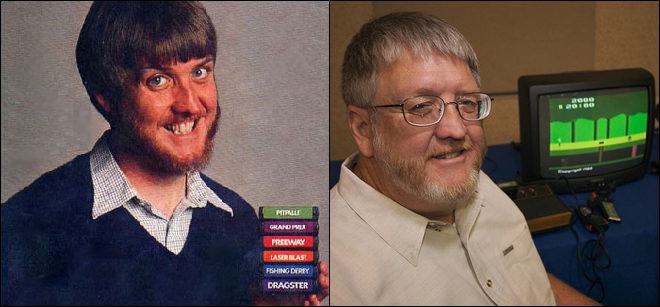
Over the years, several people have sent in questions or stories regarding some of David Crane's games, with a select few going either unanswered or unproven. Over the years, I had the chance to talk with him, and to finally shed some light on these "unsolved mysteries"!
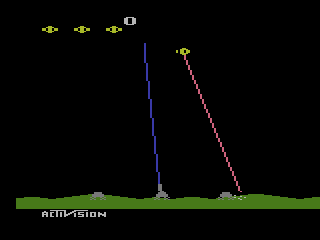 Q: A rumor with Laser Blast has long been circulated that suggests it's possible to avoid being pushed up by the force field if you keep your ship in "aim" mode.
I've tried to recreate it myself, but have been unable to. Is it actually possible?
Q: A rumor with Laser Blast has long been circulated that suggests it's possible to avoid being pushed up by the force field if you keep your ship in "aim" mode.
I've tried to recreate it myself, but have been unable to. Is it actually possible?
David Crane: I do remember that we discovered a bug in Laser Blast and changed the ROM, so there are 2 versions out there. That being the case, it is possible for one game to play differently than another. While tweaking the
gameplay of Laser Blast, it became apparent that a good strategy to avoid the lasers was to hug the
ground. The lasers could only fire at certain angles. As levels progressed the player was forced up into the danger zone to make the game more challenging.
For the Laser Blast commercial, our
child actor had to start out looking bored while earning millions of points
without even looking at the game screen of some "other space game". To
achieve this, I had to write a self-playing, single-screen space game with a big
on-screen score and provide it to the commercial production team. And, of
course, I used a 2600 for this since I had the development system; a 2600 was
portable; we had extras we could send to LA, etc.
Digital effects added in post production were not common then, so they wanted
the game to be on the kid's TV screen for the shoot. Enter Genlock - a
studio-wide standard sync signal driven into every TV camera, monitor, etc (you
can tell when Genlock is not used when you look at a TV in the scene and a black
sync bar drifts through the picture). Of course, not only is a 2600 not
equipped with Genlock, it doesn't even output an interlaced sync signal.
Taking that as a challenge, I first gave the imaginary game an interlaced signal
in software, changing the sync code to put out 262.5 scan lines so that
alternating frames provided the required 1/2 line offset for interlacing.
I then wired up an unused joystick input to read the Genlock signal and trigger
each frame to keep the sync bar out of frame.
All that for 4 seconds of the commercial. It worked so well I then had to
put the same mods into a Laser Blast cart so they could capture game play
footage. And yes, I know, I should have saved that cart.
Q: Regarding the famous VCS 6-digit score display kernel, I heard you once credited Carol Shaw for this but I believe the first VCS game to use it was Laser Blast. Is that correct?
David Crane: No, Carol was never involved with that so I can’t imagine what I might have said that would have been interpreted that way. The 6-digit score kernel was a glimmer in my eye as I was leaving Atari to start Activision. The technology was actually first used in Dragster, but I think you are right
that the first time it was actually used for score digits would have been Laser Blast.
It showed up in Imagic games. One day I ran into Rob Fulop and Brad Stewart in a mall in Sunnyvale (we had worked together at Atari). They told me that the version of the code in their games was actually copied directly out of the Dragster ROM.
That was easier than trying to figure it out for themselves.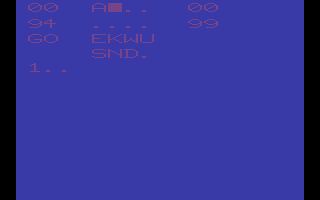
Q: Regarding your VCS Boggle game, did you do this while at Atari? And do you recall why it wasn't released?
David Crane: Yes, it was at Atari. Management looked at me like I was nuts – making a video game version of some other company’s board game. “We would have to license it from Hasbro?!?” Hasbro’s Boggle wasn’t a real blockbuster either, so they couldn’t get excited about it. But I liked the game so I did it, and I did it so quickly that it was done before anybody knew I was working on it (I assume that the ROM image made it into the homebrew world?).
Q: With Dragster, it seems every (completed race) time under 6 seconds always ends in 1, 4, or 7. Was this intentional, or a peculiar trait of the program?
David Crane: It is true that the Dragster times cannot end in all values. The game code for all 2600 games runs at 60 frames per second (30 frames for each player in a two-player game). The game timer can only tick each program execution time. The Dragster timer gets incremented by 0.0333 each 'tick', so the hundredths
digit changes by 3 or 4 with each tick.
Q: Did you start (or finish) Dragster while at Atari (since it's based or 'inspired' by Atari's Drag Race coin-op)? Would you happen to know if a similar situation occurred with Larry Kaplan’s Kaboom and Atari's Avalanche coin-op?
David Crane: No game released by Activision was even partially developed at Atari. Going into a position of competition with Atari, and therefore knowing that we would certainly be sued, we left with just the shirts on our backs. You will find other former Atari employees who, having left the company under non-competitive
situations, chose to keep programming manuals, prototypes, and even semiconductor chip plots. Such was not the case at the founding of Activision.
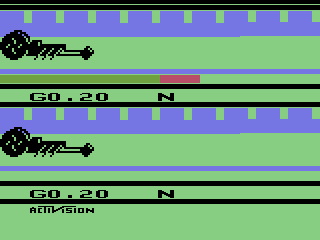
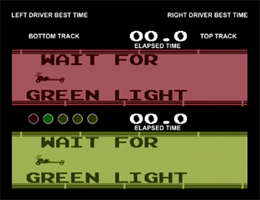
Activision's Atari VCS Dragster (left); Atari arcade Drag Race (right)
Q: How was it that Atari didn't sue Activision over these games, or did you guys feel that they were different enough to not cause any legal retaliations from Atari or other companies (such as with Megamania and Sega's Astro Blaster)?
David Crane: Games like Dragster, Kaboom, and eventually Megamania came about because the home game market was very young, and we were playing catch up with the arcade business. People wanted to have the same experiences at home that they were getting in the arcades. This was a mandate from above at Atari, but even outside
Atari the inspiration for home games often came from the arcade. Once the home game market caught up, and the arcade
gameplay mechanics had all been exploited enough, we were finally free to do much more original games.
Of course, there are other people who would tell you that there are only so many original
gameplay mechanics, and that all games borrow from the past (this is the same logic that almost closed the Patent Office in the 1890s because "everything had already been invented"). These people would always describe Freeway as "Space Race with cars," or Asteroids as "Computer Space with rocks," etc. The reality is that there was some influence from all of the
above.
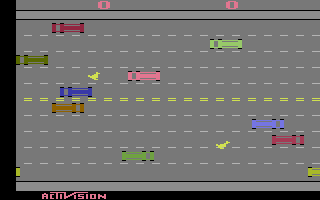
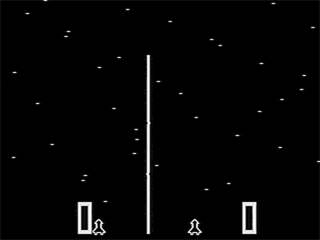
Activision's Atari VCS Freeway (left); Atari arcade Space Race (right)
As for lawsuits, there was a whole lot of suing going on over many different issues, and I am not at liberty to discuss the details of those with which I was even peripherally involved. But the underlying issue with
gameplay has to do with the fact that there is no clear protection for gameplay. You have trademark and copyright protections, you can protect the artistic design of something, and you can even protect the look and feel of something. But "gameplay" has always
proven too elusive a concept to quantify. So, Indiana Jones swung across pits on his whip only one year after Pitfall Harry swung on his vine, and nobody gave it a second thought. As far as the law was concerned, a whip is not a vine, while the
player knows that it’s the action of swinging over a pit, and the timing of that skill that makes them the same.
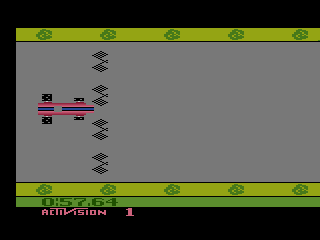 Q: I've heard a rumor about Grand Prix that there's a hidden trick which changes the finish line into your initials, and of one in Pitfall II: Lost Caverns
which allows you to play the Rhonda character at one point in the game.
Q: I've heard a rumor about Grand Prix that there's a hidden trick which changes the finish line into your initials, and of one in Pitfall II: Lost Caverns
which allows you to play the Rhonda character at one point in the game.
David Crane: Neither of those rumors is true for the 2600 versions, particularly the Rhonda story. To play the game as a different character would require that a full set of animations for the 'hidden' character be kept in the ROM. Our ROM memory was so severely limited in the 2600 that we would never waste a large chunk on
an Easter egg.
The only Grand Prix story from those days involved a record setting score. There was a particular path through the obstacle cars that a player could memorize and follow to get a near perfect score. Several of us at Activision could do it, and after release, thousands of other players were also able to achieve
it. But in this pattern, you would collide with the rear end of the last car on the track... bump him while letting a car pass right next to you... and then slip past him to the finish line. I always wondered if you could actually squeeze between these last two cars and finish at full acceleration without bumping that car.
One day at CES I decided to try to prove it. I sat in the Hospitality Suite for hours trying hundreds of times, and finally managed to time it right. It was tough because you had to play a near-perfect game just to have a tiny chance at making that perfectly timed move at the very end of the race. I had several people watching as I swooped through that tiny gap on the way toward a perfect game... right as I crashed into
the back of yet another car! It turns out that this car was never seen because it crossed the finish line and disappeared before you ever got there. What a mood swing! We all went from cheering a perfect run to watching me crash into an unknown car inches from the finish. Of course, once it was demonstrated that it was possible, a few of us were able to make that last swoop and avoid the last car for a perfect score. This could be the source of your rumor, because
it was said that I had developed a "signature move" at the finish line that blew away the established perfect score by more than a second.
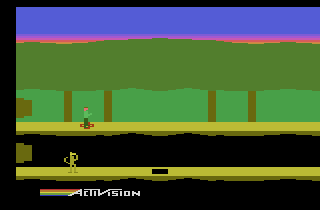
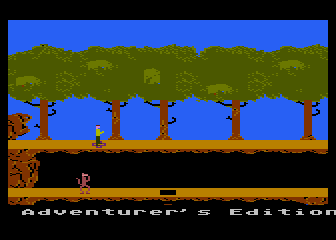
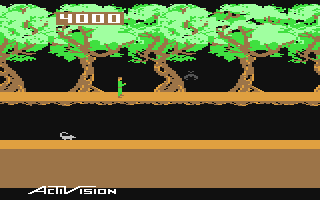
Various versions of Activision's Pitfall II: Lost Caverns: Atari VCS (left); Atari 400/800/5200 "Adventurer's Edition" (center); Commodore 64 (right).
The conversion of Pitfall II to the home computers made for an interesting story that might explain the other urban legend. The Commodore 64 and Atari 800 conversions were assigned to two different programmers who sat on either side of me in the lab. Given the assignment of taking a game written for the 2600 and converting it to another machine based on the same microprocessor, each guy took a different path. For the 800, Mike Lorenzen chose to take my code exactly and
re-write the display code and any other machine-dependent portions. For the C64, Tim Shotter went the other way and wrote code from scratch, using the 2600 game as a model. We were very interested in the results, because each method has its disadvantages. Trying to read and modify code written by someone else can be very difficult, but the code that you are starting with has already been debugged. On the other side, it is often much quicker to write code in your
own style from scratch, but you then have to debug the whole thing.
As it turned out, they both reached beta (the point where all the features are in the game, but final testing has not been done) at the same time. But Mike's game was nearly error-free while Tim's required a month of testing and debugging. During that month, Mike added an entire second world to the game (Ed: the game is sub-titled "Adventurer's Edition"
onscreen), clearly proving that his approach had been the correct one. And now that I
think about it, he may have given Rhonda some increased role in that level. But in any case, on the Atari 800 version of Pitfall II, after you complete the first level (identical to the 2600 version), you move on to a complete second level of play. This is by design and not exactly an Easter egg
(Ed: Correct, since both the computer and 5200 manuals mention the 2nd cavern
on the first page) , but this may be the source of the rumor.
Q: Did you write/score the soundtrack for Pitfall II? If not, do you recall who did?
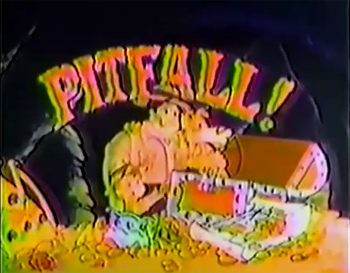
David Crane: The theme used in Pitfall II was composed for the animated series that was developed in Hollywood after the initial success of Pitfall! I made the theme music possible on Pitfall II by:
1.) Designing a special hardware circuit in the game cartridge itself that allowed 4 part music (but you already knew that).
2.) Creating a software music driver to play melody, harmony, bass, and drum parts.
3.) Writing two 4 part arrangements of the animated series theme song. The first being an upbeat main theme played over and over and over and over... and the second written in a minor key to play after a hit.
The irony was that while I thought it would benefit both the game and the series to tie in the theme song in this way, it turned out that because of the way Hollywood works, we had to pay a royalty back to the studio for the use of the theme song!
Q: Incredible! Guess there's no such "favors" in Hollywood. Was Pitfall II being developed along with the show (at the same time), or before or after it? Did you have any direct involvement with the show, perhaps as a consultant for ideas, storylines, etc?
David Crane: The TV series was developed in between the two games. I wrote the sidekick characters into the game to tie the two together.
Q: This brings me to a question that I don't think I ever asked you, or was asked of any other Activision programmer. Did you write up the manuals for your games?
David Crane: The manuals were almost always written by the marketing department, although sometimes we had to make sure that they were accurate. They often added explanations like the "force field" to describe elements of the game. It was their job to try to make the game as attractive and trendy as possible, but sometimes they got
carried away.
The worst example of this was for an Atari game (not one of mine). Atari came out with a version of Breakout for the 2600 at a time when space games were popular (Ed: The game in question is Super Breakout. Read the manual in the Archives section). The description of this game in the manual began, "You are flying through space when you encounter a multi-colored force field..."
That was when we knew they had really crossed the line.
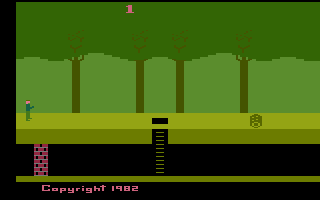
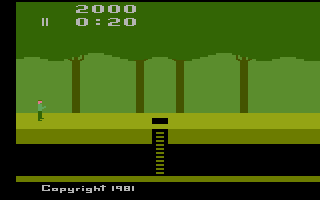
Q: I owned 2 different Pitfall! prototypes - one dated 1981 and the other 1982. The really neat thing about the 1982 version is that the background shows extra tree branches, similar to what was done with versions for other systems, such as the ColecoVision and Atari 5200!
David Crane: The 1982 version you have is of the most interest to me. This version of the game came very close to being released (I have told this story at CGE in the past, and it is an example of how the Activision design group worked). My original concept gave the player only one life to complete the game.
As you might imagine this would be very hard, and very frustrating. But game players were getting really good, and I thought this would appeal to the purists.
My cohorts disagreed, and over the last month of the project they fought for the change. It wasn't until they all ganged up on me that I began to see their point. I added the lives counter and the code to drop the new life from the region of the counter as it was decremented - visually illustrating what those tally marks represented. It just occurred to me that this may have been an industry first... I don't know for sure. It is probably
important to note that Pitfall! would never have had such wide appeal in its other form. It would have been too hard for casual players and appealed only to hardcore players.
I had completely forgotten about the extra tree branches. But looking at the sequence of events, it is only logical to assume that I had to free up memory and display kernel cycles to implement the 3 lives feature. So while I have no clear recollection of that detail, I am going to go with that explanation.
What is less clear is how the version you have with the 1981 copyright is a newer game version than the one with the 1982 copyright message. I can only assume that we were getting changing input from legal council as to which date to use. The proper notice would be "Copyright 1981, 1982 Activision Inc." But with limited space we had to choose one date or the other.
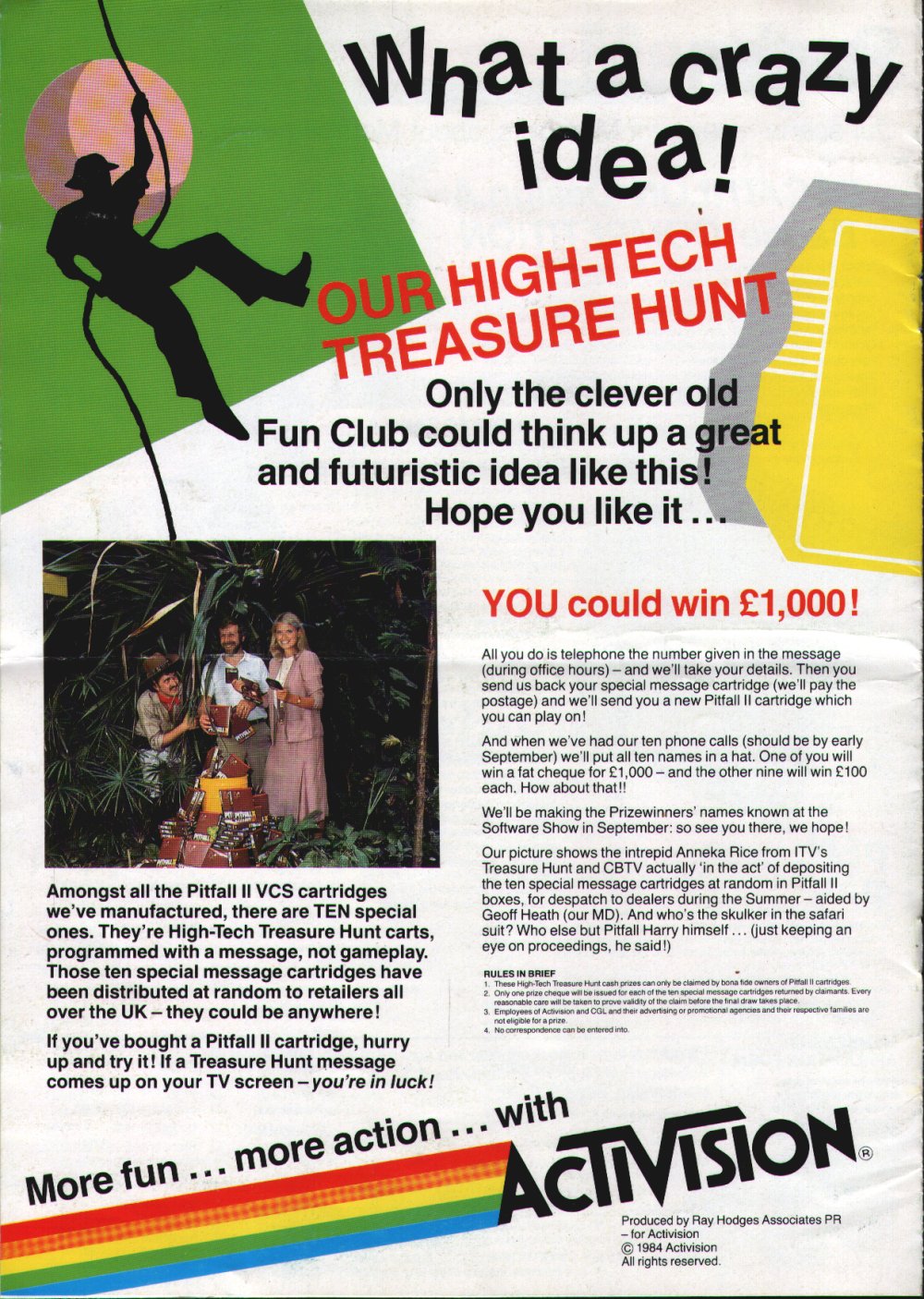
CGL Activisions Fun Club News newsletter Pitfall contest, Summer 1984 issue (click image for full size)
Q: There was a unique contest that Activision ran in the UK, through their CGL Activisions Fun Club News newsletter, where 10 specially-programmed Pitfall II cartridges were sold that displayed a message and phone number onscreen. Those who had the cartridge would call the phone number and be told where to return the cartridge. In return, they'd get a real Pitfall II cartridge and a chance to win either 100£ or
1,000£! I've never heard of this until now, and I don't know of anyone who has one of these special carts. Do you recall anything about this? I'm not even sure the contest was completed as there was only 1 more issue after this one that I'm aware of.
David Crane: I had never heard of that promotion either. But it is definitely authorized. The guy pictured in the center is Geoff Heath, the Managing Director of the Activision UK office. And the Ray Hodges Agency did the PR for Activision in 1984.
I passed the scan by Jim Levy. He didn't remember it either, but he wouldn't have been involved in a $2,000 promotion. At the time Activision International was a separate division headed by Greg Fischbach, reporting to Jim. Greg might remember but I don't see him these days (you may know Greg as the founder of Acclaim).
Since those games were returned to Activision in exchange for cash, I can see why there are no copies in the hands of collectors.
Q: The fact that Jim doesn't recall it is expected, since it appeared to be a UK-only promotion, but I'm somewhat surprised you weren't aware of it - my first guess would have been that you were involved with programming it, or someone at the main (West coast) office at the very least. Perhaps the UK office didn't want to bother asking either of the U.S. offices to program it? I wasn't aware
that any Activsion VCS programming was done outside the U.S. - would PAL conversions have been done in the UK? I know Action Graphics was also responsible for porting several Activision games to other platforms (Atari 8-bit, C-64, Colecovision, etc.) but I don't think they were involved with anything VCS-related. I agree about why no custom carts have surfaced to date. Given the circumstances, I'd be surprised if any existed at this point.
After some searching, here's what I found regarding the people involved in that contest, in case you were curious:
Geoff Heath is currently CEO of NCSoft http://www.ncsoft.com/global/
I've heard of Greg Fischbach but I haven't had the chance to speak with him. He's currently the CEO at HamptonFarms Ventures.. and apparently a frequent political contributor :)
http://www.campaignmoney.com/political/contributions/new_york_new_york_10021.asp?pg=53&cycle=08&mode=s
http://fundrace.huffingtonpost.com/neighbors.php?type=emp&employer=Hamptonfarms+Ventures
According to Wikipedia, Anneka Rice (host of "Treasure Hunt" TV show - http://www.imdb.com/title/tt0196297/) was and still is involved with various BBC shows: http://en.wikipedia.org/wiki/Anneka_Rice
David Crane: I, too, wonder who did the programming. No idea, though. PAL conversions were a minor screen timer adjustment to the NTSC game, and were done in an hour as the US game was being finalized.
Q: I contacted Greg Fischbach via LinkedIn and he doesn't recall it either. Here's his reply:
"I don't remember it, I've sent an email to Geoff Mulligan and Rod Cousens asking the same question. It certainly looks like it has Rod's handprint all over it, but I'm not sure. Hope all is well, Greg"
The search goes on.
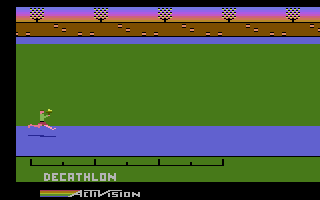 Q: Decathlon has an interesting "glitch" that allows fantastic heights to be achieved on the pole vault event (see the Easter egg
entry). Were you aware of this?
Q: Decathlon has an interesting "glitch" that allows fantastic heights to be achieved on the pole vault event (see the Easter egg
entry). Were you aware of this?
David Crane: Yes, I am aware of the Pole Vault bug. I simply forgot to de-bounce the button in the pole vault code. Since those games were made into ROMs, we didn't have the luxury of putting out revisions. When that bug was discovered we had already ordered 500,000 ROMs and we had no choice but to sell those and fix it
if we had to reorder. I don't remember if we ever revved the ROM, so there may or may not be two versions out there.
I will give you one more story that relates to this Decathlon bug. I'm sure that you are aware of the Make-A-Wish foundation that treats terminally ill children to a wish. One young gamer with a terminal illness chose a visit to Activision and his favorite game designers as his wish. We were, of course, flattered and gave him the complete tour, a copy of all the games, an afternoon in the design lab, etc, etc, etc. The Make-A-Wish Foundation people brought along a camera crew
and wanted to film him playing the latest top-secret game alongside the designer. You have probably guessed that this was The Activision Decathlon, and we played the game side by side for the cameras. This young man was a good game player and scored well on the early events. But he was clearly distracted by the lights, cameras, and glare off the TV screen, and absentmindedly pressed the joystick button several times at precisely the right point during the pole vault. You
know what the result was, and you can imagine my surprise when I looked over and saw the pole-vaulter sailing off the screen! We had never tested it that way, and this was the first time the bug surfaced. I kept my mouth shut and later that day went back to the lab to verify the bug. Unfortunately the ROMs were already being made and there was nothing we could do about it.
Q: Do you recall any of your other games having 2 or more ROM versions that were released (besides Laser Blast and possibly Decathlon)?
David Crane: Fortunately, no. Unlike today, it was a very big deal to rev a video game ROM. We tested the heck out of our games and only changed the ROM code under very limited circumstances. However, occasionally we would discover something that didn't quite work in the way it was intended. But if it didn't make
a big difference in the gameplay we just said, "That's not a bug, it's a feature".
I have heard this line many times since, but we may very well have been the first to coin that phrase back in the late 70s.
Q: The company WayForward released a remake of A Boy and His Blob for the Nintendo Wii (LINK) and those who preordered it even received a free foam Blob (LINK)! Were you aware of this?
David Crane: I have been repeatedly asked about this since its development was announced almost a year ago. And in case you are asking, no, I am not involved in the project. But I had not yet seen the “Announcement Trailer”, thanks. Cute idea turning him into a boy-shape, presumably as a decoy.
Q: I noticed from your curriculum vitae on your website that you were involved with the Hasbro NEMO project. There isn't much information available on the NEMO, other than the early version(s) used a modified Colecovision for displaying a picture. I've heard it known by several different names:
NEMO (aka Never Ever Mention Outside, from Owen Rubin), while still at Axlon
Interactive Video Player (from your site)
Isix VHS Interactive Movie (from Michael Becker). Apparently this was when Tom Zito left Axlon to form his own company, called Isix?
Control-Vision (last name before Hasbro cancelled the project)
Apparently Zito hired several prominent figures in the industry to work on it, besides yourself (Steve Russell, Rop Fulop, Michael Becker and the other names I've heard attached to it). I know you started a few years after the project started, and left near the end (or at the end) when it was cancelled. I was hoping to get more information about it, and about your contributions regarding the custom video display circuit.
From Owen Rubin:
| "I was there for Nemo, and did some editing on Night Trap (AKA Scene of the Crime), but only a small amount, mostly on editing, and consulted on the MTV title which I do not see you mentioning, but I believe Ed Norton’s Sewer Race (later called Sewer Shark) was already done. I do not recall Tech Force. Did you know that NEMO stood for Never Ever Mention Outside?" |
David Crane: The company began as Hasbro Interactive, a wholly-owned subsidiary of Hasbro Toys and run by Tom Zito. The project was called NEMO. As the product neared completion the name Isix was trademarked as the product’s public image.
The most knowledgeable person about the technology was a guy by the name of John Perkins from Chicago. If you can find him and he is willing to talk, you will probably learn more than you would ever want to know.
Given David Crane's extensive career history, instead of including a list of titles, I'm including links to his resume and portfolio. David also allowed me to archive a book that Activision put together, detailing their involvement with the Special Olympics in 1983.
In 2010, David came out with some VCS-related iPhone apps (2600 Magic and Dragster Magic) that are worth checking out.
In 2012, David attempted to raise close to $1 million to do a new Pitfall-esque game, Jungle Adventure, on Kickstarter, with nothing more than a brief outline of the game and some artistic sketches. One has to wonder why he needed to be fully prepaid for the game's development, instead of just making the game and then selling it, especially considering how weak the effort was to pre-sell it. When asked why he didn't seek venture funding, he refused to answer (LINK). Needless to say, the campaign failed, having only collecting $31,207 (LINK). No word on whether or not he refunded the money.
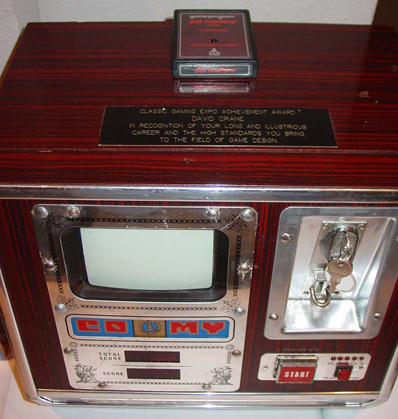
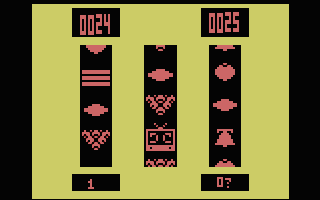
Customized video Slot Machine award (created by Scott Stilphen - custom ROM) given to David Crane at the 2002 Classic Gaming Expo
Here's Activision's 1981 "Video Update" promotional video featuring Bob Whitehead, David Crane, Alan Miller, Larry Kaplan, and Jim Levy. Also shows the commercials for Laser Blast and Skiing, and video footage of Stampede, Ice Hockey, Boxing, Dragster, Bridge, Fishing Derby, Checkers, Tennis, Freeway, and Kaboom!
Here's Activision's 1982 promotional video featuring Alan Miller, Larry Kaplan, Bob Whitehead, David Crane, Steve Cartwright, and Jim Levy. Also shows video footage of Tennis, Skiing, Laser Blast, Ice Hockey, Kaboom!, Stampede, Freeway, Barnstorming, Grand Prix, Chopper Command, and Starmaster.
Here's the Activision commercials for David Crane's Atari VCS/2600 games Dragster, Laser Blast, Freeway, Pitfall!:
Here's the Atari designers keynote from the 2007 and 2014 Classic Gaming Expos with David Crane: